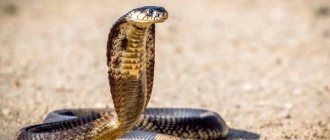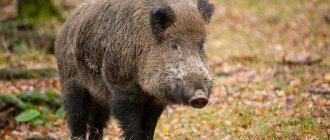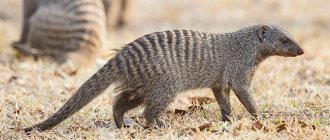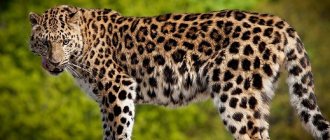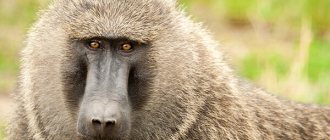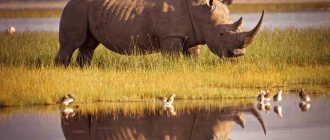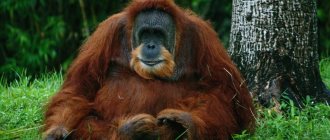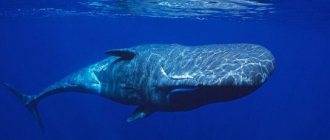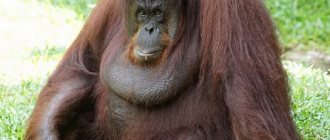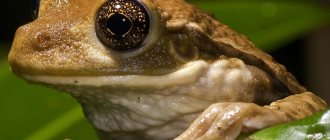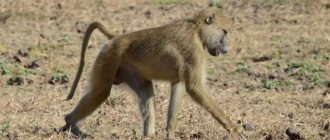Origin of the species and description
Photo: Cobra
Cobra is the common name for a whole group of snakes. They all belong to the same family - Asps. Most of these reptiles belong to the true genus. The concept of “cobra” first appeared in the sixteenth century. It was at this time that a spectacled snake first met on the man’s path. She surprised the travelers with her unusual “hood”.
Interesting fact: The so-called hood appears in snakes only in case of danger. It is formed from skin folds that hang on the sides.
Representatives of the cobra genus have strong poison. However, the bite of such reptiles differs from the bite of other cold-blooded animals. The venomous teeth of cobras are quite short. They are much smaller than those of vipers. Therefore, much more effort must be made to inject venom into a reptile's prey. At this time, the animal holds the victim in a death grip, preventing it from escaping until the poison is completely injected.
Interesting fact: Representatives of this genus never bite without prior warning. For this they are called noble snakes.
As already noted, there are about sixteen species of cobras.
Among them, it is worth highlighting the five most famous:
- Royal. This is the largest representative. King cobras are widespread in India, China, Vietnam and other countries. The reptile can reach almost six meters in length, and its poison can even kill an elephant.
- Indian. This reptile is much smaller than the royal one. Its length does not exceed two meters. The Indian cobra has a bright color: yellow-gray, black, brown. When the hood opens, a white pattern in the form of ring-shaped spots can be seen on the snake.
- Central Asian. Lives in gorges, near rivers among sparse vegetation. They go hunting during the day and live in small groups. There is no characteristic glasses pattern on her back.
- Egyptian. It is also called gaya. She lives in northern Africa. Its weight is about three kilograms and its length is two meters. It has a narrow hood, monochromatic colors - various shades of brown.
- Ringed water. This animal can reach a length of almost three meters. The reptile's back is yellow-brown with periodic light stripes. The ringed cobra's main diet is fish, but it sometimes eats toads and frogs.
Appearance and features
Photo: King Cobra
Cobras are nature's most beautiful creatures, despite the danger they pose. Their appearance is very expressive and memorable. The length of such animals ranges from two to four meters, depending on the species. Weight can reach six kilograms. However, larger samples are also known to mankind. For example, a reptile 5.7 meters long lived in one of the London zoos for a long time.
This deadly snake can reach high speeds and is agile, despite its large dimensions. The color of its skin can be olive, green, black, brown, light yellow. On the back there are usually stripes, specific spots that resemble glasses.
Video: Cobra
Males can be distinguished from females even by size. There are much more males. The mouth of such reptiles can stretch to enormous sizes. This opportunity allows the animal to feast on prey of different sizes. In front of the mouth are two pronounced sharp fangs. It is through them that the channels with poison pass. Another distinctive feature of cobras is their hood.
The hood has one clear purpose - to scare away rivals and enemies. If the snake demonstrates it and hisses menacingly, it means that some animal or person is too close. To further demonstrate its readiness to bite, the reptile may begin to rush towards the enemy. This ritual usually works brilliantly - the snake is left alone. But sometimes the cobra has to fight.
Where does the cobra live?
Photo: Cobra
Representatives of the cobra species are very thermophilic. They cannot live where there is snow cover. However, there is an exception. The Central Asian species lives in the north of Tajikistan, Turkmenistan, and Uzbekistan. There, the ambient temperature in autumn and winter is quite low and almost the entire territory is covered with snow.
The main habitat of such reptiles is the countries of Asia and Africa. In Africa they are found everywhere throughout the continent. Asps also live on the Philippine and Sunda Islands. Representatives of this species cannot be found in Europe, Russia, or Ukraine.
Reptiles put forward a number of requirements for their home:
- warm climate;
- availability of suitable food;
- distance from cities and people.
Cobras prefer to settle in arid, desert places. They live in semi-deserts, savannas, deserts, and tropical forests. A small population is also found in the mountains. However, only up to a height of two thousand four hundred meters. Reptiles do not climb higher.
Interesting fact: Cobras prefer to live in the wild. Then they can live about twenty years. In a city environment, too many dangers await a poisonous snake.
In tropical forests, reptiles do not hide in bushes or under stones. They are quite active: they can swim and climb trees. There is a separate type of cobra that spends most of the day in water, where they hunt. They settle mainly near rivers.
Tiger attack: dangerous predators from the cat family
Tigers remain another dangerous animal that you may encounter in India. The danger mainly affects residents of rural settlements and visitors to national parks. For these big cats, humans remain a potential dangerous enemy and at the same time prey, so an encounter with a tiger poses a real threat to life.
In the last 7 years alone, 11 people have died from predator attacks in Bandhavgarh National Park. Two more were killed in Kanha National Park. The problem arises from the overabundance of animals in a limited area of the national park: when there are too many tigers, they become more aggressive, actively protect the territory and turn into a threat to tourists.
In Bandhavgarh, the tiger population now stands at 35 individuals per 100 sq. km, which is quite a lot considering the limited hunting grounds. As a result, animals become crowded, and it is much easier to attack people than wild representatives of herbivores. A person becomes an easy prey, especially if he is not ready for an attack and is confident in his own safety. When the population density is high, the management of the reserve relocates “extra” tigers to other national parks in the country or to large zoos.
The attacks are partly provoked by the tourists themselves. If animals are nervous due to excessive noise or intrusive attention, this can lead to conflict and a tragic outcome. When going on a trip to a national park, you should not neglect the safety advice of your guide, because the wild predator poses a serious threat to life. In this regard, there is no need to tease animals, but behave with extreme caution.
What does a cobra eat?
Photo: Cobra head
Reptiles obtain food mainly during the daytime. Most representatives are predators. Their main diet consists of small rodents (vole mouse) and amphibians. They prefer to feed on toads, frogs, lizards and even some other types of snakes. Their food is often smaller reptiles, even poisonous ones. The king cobra feeds exclusively on other reptiles.
Also, representatives of this group are not averse to eating birds. Ground-nesting birds are chosen as food. Some cobras eat fish that they catch in rivers. A small part of snakes do not even disdain carrion or other people’s eggs.
Fun fact: Cobras have a Jacobson's organ. Thanks to him, they have a very developed sense of smell. A keen sense of smell allows reptiles to easily smell prey in almost any conditions, even at night. Therefore, some snakes hunt at night, and during the day they rest in trees or in some secluded place.
Reptiles first wrap their entire body around their future food and then kill it with a bite. The venom of these animals is very strong and acts almost instantly. Time is required only to introduce the toxin into the victim’s body, so cobras hold the prey in their teeth for a long time, allowing the poison to completely penetrate inside.
9. Rhombic rattlesnake (lat. Crotalus adamanteus)
Being the largest venomous snake in North America, its length reaches 2 meters. Diamondback rattlegrass is commonly found between North Carolina and Florida, as well as western Louisiana. If you provoke such a snake, it will become very aggressive, and an encounter with it can end in death. A rattlesnake bite will deliver a large amount of potent poison into the body, causing severe internal pain, bleeding at the site of the bite, swelling, and a high risk of death. In the absence of timely treatment, approximately 10% -20% of people die after one bite from this snake.
Features of character and lifestyle
Photo: Animal cobra
The lifestyle of cobras is similar to the lifestyle of almost all reptiles. They prefer to live alone. The only exception is the king cobra. During the mating season, representatives of this species form strong, long-term pairs. These animals are most active during the day. They are not afraid of high temperatures and lack of moisture. Cobras are resistant to overheating. Reptiles lead an active lifestyle: they swim, crawl on the ground, mountains, and trees.
The character of reptiles is quite calm, although in the minds of most people these animals are very aggressive. This is a misconception. Reptiles of this group are a little phlegmatic and rarely show aggression without reason. This nature makes deadly snakes amenable to training. They are easy to control with a detailed study of the animal's behavior.
Cobras hunt in two ways:
- Biting the victim. Through a bite, poison is injected into the opponent, which over time leads to death.
- Shooting poison at prey. This method of hunting is characteristic of only some representatives of the group. In particular, the Indian cobra. She is considered the most accurate shooter. The poison flies out of the mouth under a certain pressure. The reptile can fire several shots at once, which significantly increases the chances of a hit.
What to do if you are bitten by a snake?
- Start sucking out the poison by rinsing your mouth. If there are wounds on the tongue or the walls of the cheeks, then ask another person to take care of this matter
- Take anti-allergy medications
- Drink plenty of water and stay still. With increased activity, the poison will begin to spread through the blood
- Wait for an ambulance or take the patient to the nearest town
- Remember that anti-snake serum is used half an hour after taking prednisolone in the area between the shoulder blades.
If you are bitten by a snake, it is strictly forbidden to:
- Make a tourniquet
- Cauterize the bite area
- Cut the bite site.
Social structure and reproduction
Photo: Cobra
The breeding season for cobras occurs in January-February or spring. Indian cobras prefer to breed in winter, and Central Asian cobras in spring. Eggs are laid several months after mating: in April, May, or in the first two months of summer. Each representative of the species has its own level of fertility. On average, the number of eggs ranges from eight to seventy eggs at a time.
Eggs are laid in secluded places. Most often these are crevices in rocks or a small pile of fallen leaves. There are cobras that immediately give birth to live young. We are talking about a collared snake. This reptile is capable of reproducing up to sixty individuals at a time. The females are responsible for protecting the masonry. Some representatives of the group not only protect, but also arrange a cozy nest for future offspring. Males also take an active part. They stay with their chosen one until the offspring hatch.
During the development of offspring in eggs, some representatives of cobras show aggression. For example, Indian, king cobra. They are very active and aggressive in driving strangers away from their nests. In case of great danger, they can unpredictably attack enemies, even humans. Baby snakes are born absolutely independent. At the very beginning, they produce a little poison, so young individuals hunt mainly small prey. Even some insects can become their food.
Natural enemies of cobras
Photo: King Cobra
Even deadly animals have enemies. Cobras are no exception. They are especially at risk immediately after hatching. Young individuals are hunted by other snakes, monitor lizards. The venom of young animals is not so strong, so reptiles cannot defend themselves. The enemies of adult reptiles are meerkats and mongooses. These animals are very dexterous and cunning. They are not immune to snake venom, but they skillfully cope even with large reptiles. Meerkats and mongooses first distract the snake and then bite it in the back of the head. This bite becomes fatal to the animal. It is almost impossible to escape from a mongoose or meerkat.
Interesting fact: Many adult cobras are killed by cars. They randomly end up on the tracks. When encountering a car, the reptile does not run away, but tries to scare it away. As a result, it ends up directly under the wheels of the vehicle.
To protect themselves from natural enemies, cobras have a number of adaptations. They take a frightening stance and inflate their “hood”, emit a menacing hiss, and some species know how to pretend to be dead.
Population and species status
Photo: Cobra animal
The natural population of most cobra species is considered to be in gradual or moderate decline. Snakes live long only in wild conditions: deserts, savannas. It is not easy to track their numbers, so there is no exact data. Only the Central Asian cobra is listed in the Red Book. The number of such reptiles is quite low and is still declining.
Steppe viper
Tourists can encounter the steppe viper in Russia, in particular in Crimea. She lives in the steppe regions of the peninsula.
The steppe viper is small in size. There is a peculiar zigzag line on the back of the snake. The viper will not touch a person until it understands the danger. However, in the resort area there has not yet been a single case of death from a steppe viper bite.
